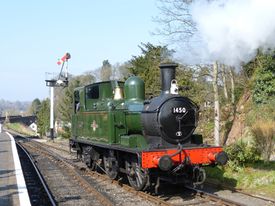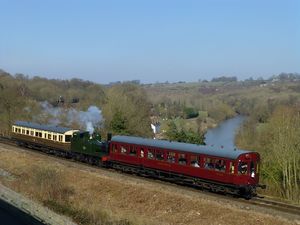| GWR 1450 | |
|---|---|
 1450 at Bewdley in 2015 | |
| Built By | GWR Swindon Works |
| Configuration | 0-4-2 |
| Power class | GWR: Unclassified, BR: 1P |
| Axle load class | GWR: Unclassified |
| Status | In Service |
| Loco Number | 1450 |
| Other Numbers | 4850 |
| History | |
| Built | 1935 |
| Designed By | Charles Benjamin Collett |
| Type | GWR 1400 |
| 2014 | Arrived on SVR from DFR |
| Technical | |
| Length | 29ft 11in |
| Weight | 41t 6cwt |
| Tractive effort | 13,900 lb |
| Pressure | 165 lb/sq in |
1450 is a GWR Collett 1400 class 0-4-2T locomotive, designed for work on small branch lines.
Contents
1400 Class information
1450 (originally 4850) is a GWR 1400 class 0-4-2T locomotive. These locomotives, which were originally numbered in the 4800 series, were designed by C.B. Collett as a replacement for the elderly Wolverhampton '517' class, and were intended to work mainly on small branch lines. 75 were built at Swindon in three batches between 1932 and 1936, being fitted from new with auto gear for working with trailer cars and also with ATC (automatic train control) equipment. 20 other locomotives of the same class, numbered 5800-5819, were built in 1933 without auto gear and ATC, although some were retro-fitted with the latter. Following nationalisation BR rated the class 1P.
Post-1945, coal shortages led to plans being put forward to convert a number of GWR engines to oil burning. 12 of the 2800 class freight engines were modified and renumbered in the 4800 series. As a result the entire 4800 class was renumbered 1400 to 1474 by the GWR in 1946.[1]
Three other members of the class have survived into preservation; 1420 at the South Devon Railway, 1442 at Tiverton Museum and 4866 at the Great Western Society in Didcot.
1450 in service
4850 was built in 1935 to lot number 288 and first entered service at Oxford in July 1935.[2] It was re-numbered 1450 by the GWR in 1946 and re-allocated to Slough in April 1951. While based there it was photographed in 1955 at Bourne End working an autocoach service to Maidenhead.[3]. A return to Oxford in September 1959 was followed by further re-allocations to Exeter (July 1962), Taunton (November 1963) and Yeovil Town (October 1964) before a final move to Exmouth Junction in February 1965. 1450 was finally withdrawn from service by BR in May 1965,[4] after a working life totalling 823,012 miles.
1450 in preservation
1450 spent her early life in preservation at the Dart Valley Railway (now the South Devon Railway). She was eventually purchased from there and re-located to the Dean Forest Railway by Pull Push Limited, her present owner, of whom Mike Little is a director.[5]
1450 arrived at the SVR from the DFR in March 2014, initially on hire for the year. Subsequently 1450 has been listed as part of the home fleet. Although not powerful enough to haul service trains on her own 1450 did so in 2014, double heading with 4566 to provide the required power, due to a number of ongoing locomotive repairs leaving the SVR unexpectedly short on engines. The locomotive is regularly used on Footplate Experience duties, as well as appearing on charters and at galas on the SVR and elsewhere. She is often paired with the owner's autocoaches 178 and 238 which are also resident on the SVR.
Whilst 1450 was winterised at Bridgnorth MPD over 2017-18 she returned to GWR livery, at the owner's request, for the remainder of its current boiler ticket.[6]
During 2019 the locomotive will be visiting the Didcot Railway Centre from the end of April until early September[7]. GWR Large Prairie 4144 was on loan to the SVR from Didcot for summer 2019, an arrangement which suited both parties.
See also
References
- ↑ Rail UK Steam Loco Class Information -- GWR 1400
- ↑ Great Western Archive
- ↑ Signalman’s Reflections, Adrian Vaughan, 1990, p68
- ↑ BR Database
- ↑ SDR web site, retrieved 25-01-2015.
- ↑ SVR Twitter 1 January 2018
- ↑ Didcot Railway Centre website
Links
| ||||||||||||||||||||||||||||||||||||||||||||||||||||||||
